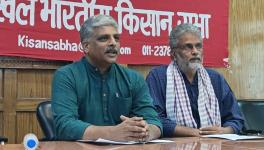Elections 2019: In Bihar, Talk of MSP Remains on Paper for Most Farmers
File Photo: Has There Been an MSP Hike for Kharif Crops?
Surajdev Yadav, a young, hard-working farmer in Gaya district, is in distress. This year, he is being forced to sell paddy below the minimum support price fixed by the Bihar government after a drought hit crops in the Kharif season.
Yadav, in his mid-30s, says he has been facing the curse of nature as well as man-made exploitation since the few years.”Sukha (as drought is locally known) ke saath sarkar bhi kisan ko maar raha hai”, ( Apart from drought, the government is also killing farmers) he says while walking toward his dry farmland near village Dhorhi in Gaya district of Bihar.

Pictures by Mohd Imran Khan: Surahdev Yadav
Yadav rues that he has not got any benefit of MSP. “I have no option but to sell 20 quintal paddy below MSP.I got Rs 1,300 per quintal, which was Rs 450 less than the rate fixed by the state government”, he adds.
The Janata Dal-United/Bharatiya Janata Party-led government in Bihar has fixed MSP of Rs 1,770 per quintal for paddy, and hardly miss any opportunity to claim that it provides ‘fair and remunerative’ prices to farmers for their crops. The vyaparmandals (trading bodies) and PACS (Primary Agriculture Credit Societies) have been engaged in directly procuring paddy from farmers at the MSP fixed by the government.
Yadav, however, says he was forced to go in for distress sale of paddy, contrary to the state and Central government’s much hyped claimed to provide MSP. “Farmers are in distress and are helpless. The talk on MSP is only on paper. Even PACS exist only in name, as we are forced to sell paddy to local traders or middlemen”, he told Newsclick, giving a peek into the tough life of a marginal farmer, particularly in drought0-hit area.
Yadav is one among millions of farmers across Bihar who were impacted by one of the worst droughts in the state last year during the kharif season, which also affected rabi season this year.
Another farmer, Karu Prasad, of Lakhaipur village under Mohanpur block in Gaya, has got a little more for his paddy than Yadav, which he sold to a local trader. Mohanpur is one of the 275 blocks in 24 districts declared drought-hit last year in Bihar.

Pictures By Mohd Imran Khan: Karu Prasad
“I sold five quintals of paddy at the rate of Rs 1,400 per quintal, much below the MSP”, says Prasad.
Yadav and Prasad blame the government agency for distress sale of paddy.
Prasad says the life of a small farmer like him has becomes worse, adding “we are struggling to pay back whatever credit we take for farming”.
“We are small farmers. How can we wait for three to four months for money after selling paddy to PACS? We need money as soon as possible, but PACS delay for months. This has discouraged us and pushed us to sell paddy to traders or middlemen who pay us immediately” Prasad says.
Accusing the PACS of “playing games” with local traders and middlemen by “forcing us to sell our produce below MSP”, Prasad blames the “well designed nexus of PACS with local traders and middlemen with support of concern administrative officers” for the plight of small and marginal farmers.
Prasad told Newsclick that not just MSP, has not got a single penny from the Pradhan Mantri Kisan Samman Yojna (PMKSY) till date, which assures Rs 6,000/year to eligible small and marginal farmers with less than 2 hectares land.
“I had spent Rs 300 to apply online for it. I am still waiting”, he says, adding that officials keep telling them to wait for PMKSY benefits, but “I strongly doubt that it is like any other promise made by the government”.
Fazlu Khan and Shankar Singh have a similar story. Khan belongs to Raghunathpur village under Haspura block in Aurangabad district and Singh is from Rampur village in Rohtas district, known as the ‘rice bowl’ of Bihar. Both the farmers were forced to go for distress sale of paddy in view of “apathy and unnecessary harassment” by PACS officials.
“Farmers are not ready to get trapped as even after procurement, PACS usually makes delayed payments for paddy. This is main reason farmers prefer to sell paddy to traders or middlemen instead of PACS”, they say.
Yadav, Prasad, Khan and Singh have a common complaint -- that farmers’ distress is neither a poll issue nor a serious concern during the ongoing campaign for Lok Sabha polls.
This reality is reflected in the Bihar government’s own data till March 31, 2019, the last date of paddy procurement by PACS from farmers. The government agency and the vayaparmandals directly procured 14,24,882.299 tonnes of paddy from 2,11,111 farmers in Bihar. This is less than 50% of the target fixed by the government itself. As per government records, there are more than 1.6 crore farmers In Bihar.
According to officers in the agriculture department, the paddy procurement process started in the state in mid-November 2018.
Last year, the Bihar government set a target to procure 30 lakh tonnes of paddy from farmers till March-end this year (Kharif season is from November 2018 to March 2019).
However, in 2017-18, about 11.84 lakh tonnes of paddy was procured by PACS, whereas in 2016-17, it bought 18.42 lakh tonnes, while it purchased 18.23 lakh tonnes in 2015-16.
In one of the largest paddy producing districts of Rohtas, only 13,757 farmers get MSP for selling a total of 14,5614.920 tonnes to PACS, followed by Kaimur district where 12,275 farmers sell 14,1417.09 tonnes of paddy to the government agency. In
Nalanda, the home district of Chief Minister Nitish Kumar, 15,430 farmers sold 73,416.397 tonnes paddy at MSP.
The highest number of farmer – 19,383 – is Patna district, who sell 11,2691.203 tonnes paddy to PACS.
A top agriculture department officer said production of rice has declined this year due to a drought-like situation. Last November, disaster management department officers had also cautioned that drought may lower paddy production.
According to officials, Bihar recorded rice production of 74.15 lakh tonnes during the Kharif season in 2018-19, against 79 lakh tonnes in 2017-18, declining by 4.85 lakh tonnes.
Paddy is main Kharif crop and its production has been affected by the poor monsoon. Total paddy production in kharif season in 2018-19 was 111 lakh tonnes, which is 9 lakh tonnes lower than in 2017-18.
As per official records, paddy yield declined to 23.92 quintals per hectare against 24.09 quintals per hectare in 2017-18 and 25 quintals per hectare in 2016-17.
Agriculture is the backbone of Bihar's economy, with 77% workforce generating nearly 24.84% of State Domestic Product.
Get the latest reports & analysis with people's perspective on Protests, movements & deep analytical videos, discussions of the current affairs in your Telegram app. Subscribe to NewsClick's Telegram channel & get Real-Time updates on stories, as they get published on our website.























